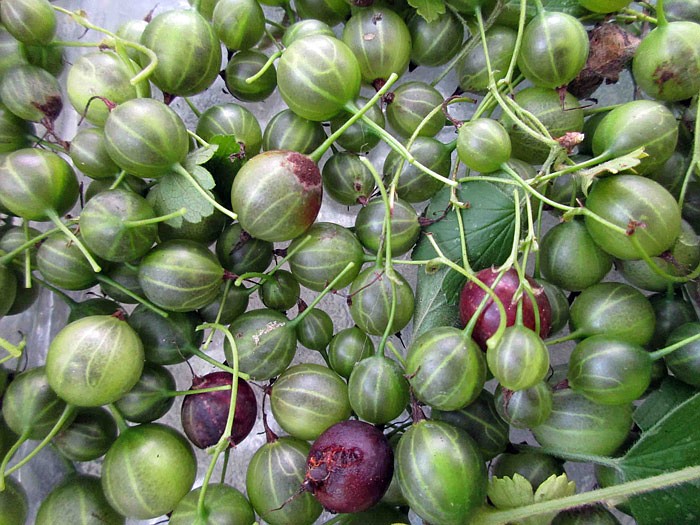Gooseberry pies are tart and delicious, but if you think gooseberries are only good in sugary desserts, you may want to expand your horizons.
I didn't give gooseberries a second thought for years and just settled for gooseberry pie; however, their tartness can also be used in a variety of savory recipes. In fact, you may want to experiment with gooseberries in any recipe that calls for a tart or sour ingredient like tomatoes and even lime or lemon.
One recipe my husband, Randy, prepares is what he calls "Gooseup," which can be used to replace catsup or served as a condiment with seafood, chicken or on a toast with your favorite cheese. He also once cooked a Moroccan-style chicken tagine using gooseberries to substitute for rhubarb. (In Randy's blog, 'Nadia's Backyard', you can find more of his take on this Missouri native nadiasyard.com/2015/06/17/backyard-gooseberries-are-saucy-little-things/)
Back on the sweet side, a jam prepared by Megan Fox, of Blue Fox Farm in Ashland, is really delicious. She mixes gooseberry and elderberry juices, and the tartness of the gooseberry with the deep purple color of elderberry make this jam very appetizing to put on your favorite sugar cookie or on a crunchy toast.
Now, some may hate the thought that gooseberries are usually cleaned one by one before using them in recipes - a very time-consuming proposition. The good news is you may be able to skip that tedious task. In "Cooking Wild in Missouri," author Bernadette Dryden offers a couple of tips to cook with gooseberries. She recommends pressing the gooseberries to make pulp and straining them through a sieve for recipes that call for the juice or just leaving the stems and tails on for recipes like gooseberry pie.
Gooseberry blooms in April and May, and berries can be picked green from June through August. When mature, they are dark-pink and lose some of the tartness.
According to Don Kurz in his "Shrubs and Woody Vines of Missouri," there are two native gooseberries in Missouri: the most common one is Missouri gooseberry Ribes missouriense, which naturally grows in all but nine counties, and prickly gooseberry Ribes cynosbaty, which is only found in 20 out of 114 Missouri counties. A European gooseberry, Ribes uva-crispa, was also introduced from Europe. Gooseberry is related to wild black currant (Ribes americanum) and golden or clove currant (Ribes odoratum). All are edible.
Golden currant has aromatic flowers, resembling the smell of cloves, which can be pickled and used in recipes calling for capers. What separates currants from gooseberries is the latter have prickly stems and currants have smooth stems. Gooseberries and currants can be found in local nurseries.
Below is my recipe for gooseup. We served it on a flat bread with goat cheese on top and sprinkle a few raisins to balance the tartness. (This tip was provided by Taylor Cleveland, owner of Taylor Made, a food delivery business in Jefferson City.)
Dr. Nadia Navarrete-Tindall, previously an associate professor for Lincoln University Cooperative Extension, is now a native plant specialist independent consultant. She can be reached at [email protected] or on Facebook: Native Plants Program. She offers educational workshops about native edible plants and other topics on native plants as well as consultation on native plants for your yard.
GOOSEBERRY CHUTNEY (aka 'GOOSEUP')
Makes: 5-6 servings.
1 cup of gooseberries with tails- no stems
1 teaspoon olive oil
1 teaspoon sugar
1 teaspoon Worcestershire sauce
1/2 teaspoon salt
1 cup tomato juice
2 large cloves of garlic or 1 medium onion diced
In a saucepan, add oil at moderate heat. Add garlic or onion and sauté for a few minutes.
Add gooseberries and other ingredients. Cover and let simmer for 5-7 minutes.
Smash with a spoon for a chunky consistency or use your mini food processor for a smooth consistency.
Let it cool, then serve with chicken or as a spread on crackers or toast topped with goat cheese.


